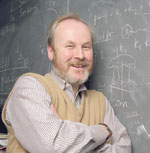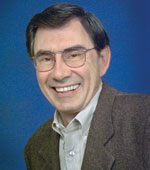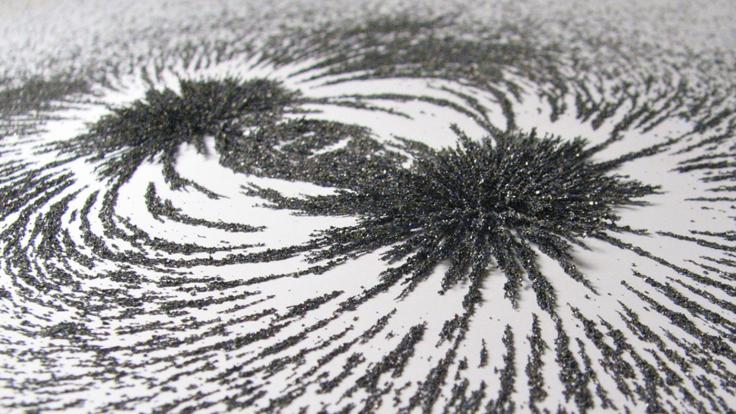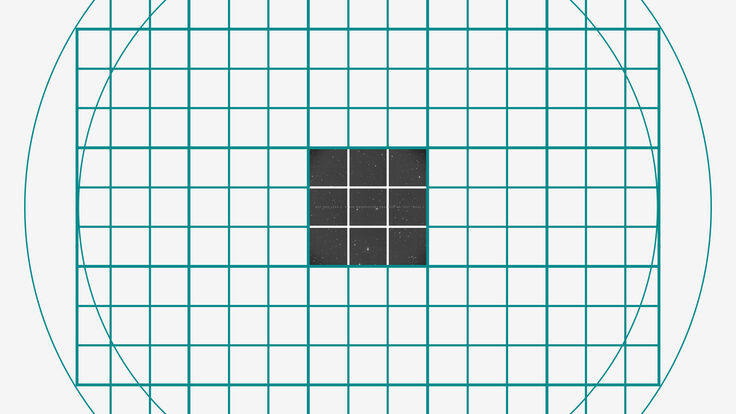Essay: R. Keith Ellis and Thomas Ludlam
Strong interaction
More than thirty years after publishing two scientific papers on the theory of the strong interaction, David Gross, David Politzer, and Frank Wilczek received the 2004 Nobel Prize in Physics. symmetry asked two physicists—a particle physics theorist and a nuclear physics experimentalist—to explain how the papers paved the way for one of the most successful theories in physics and how new experiments are testing its predictions.
 Photo: Fermilab |
The Advent of QCD
I was delighted to wake up on the morning of October 5 and find that David Gross, David Politzer and Frank Wilczek had been awarded the 2004 Nobel Prize for the discovery of asymptotic freedom in the theory of the strong interaction. Their discovery in 1973 resurrected the role of field theory in strong interactions and initiated the development of Quantum Chromodynamics (QCD). In one fell swoop, all the methods of Quantum Electrodynamics (QED) could be applied in the new theory, albeit with a number of subtle differences.
However, the discovery of asymptotic freedom did not mean that Quantum Chromodynamics was immediately accepted as the theory of the strong interaction. Richard Feynman, in particular, was unconvinced until about 1980, believing that a correct theory should quickly explain and predict many phenomena, as it had with QED. The effects predicted by QCD vary only as the logarithm of the energy scale. At low energy the logarithms are confused with other preasymptotic effects; at high energy, a large lever arm in energy is required to observe these logarithmic effects. So it took some time until these logarithmic effects were confirmed.
The work of many people was required to turn the fledging theory into a reliable calculable structure. David Politzer was particularly active in this stage, teaching us that perturbation theory contained both long distance parts and short distance parts, which need to be separated. Since, at useful energy scales, the coupling was about 10 times larger than the QED coupling, it was quickly appreciated that radiative corrections would be of great importance in the verification of this theory. In this regard, I would like to acknowledge the contribution of William Caswell, who showed that the behavior found by Gross, Wilczek and Politzer persists when the calculation is improved by including radiative effects. Further details of the joy and frustrations of QCD radiative corrections can be found in the poignant obituary of Caswell, written by Frank Wilczek and Curt Callan, and published in Physics Today in December 2001.
One of the problems of asymptotic freedom is the difficulty of providing a cogent and simple explanation of the phenomenon. To say that it is all to do with a minus sign, which is true, somehow belittles the achievement and makes it seem like a banality. It is often said that the force between quarks is weak at short distances and strong at long distances; and on Nobel morning, more than one commentator described the analogy of a stretched rubber band whose restoring force diminishes as the two ends are brought closer together. But in fact, asymptotic freedom only provides a logarithmic variation on top of the QCD equivalent of the Coulomb force. The force between quarks does not become weak at short distances; it is only slightly weaker than it might have been with a fixed coupling. So it is more correct to say that the coupling gets smaller at high energy. It is the smallness of this coupling which allows us to predict phenomena at the Tevatron and the Large Hadron Collider. These predictions are the true legacy of the discovery by Gross, Politzer and Wilczek.
R. Keith Ellis is a theoretical physicist at Fermilab. He is the co-author, with Bryan Webber of Cavendish Laboratory, University of Cambridge, and James Stirling, University of Durham, of QCD and Collider Physics.
 Photo: BNL |
Testing QCD with Nuclear Collisions
The discovery that earned David Gross, David Politzer, and Frank Wilczek the 2004 Nobel Prize in Physics—that the strong, or "color," force binding quarks together grows weaker as two quarks become closer, and is stronger as quarks are pulled apart—spawned a new physics theory with a profound impact on experimental nuclear and particle physics. Many aspects of the new theory have been confirmed, and new insights revealed, in high-energy collisions of elementary particles (electrons, protons, and anti-protons) carried out using large accelerators at laboratories around the world.
Motivated by this new theory, known as Quantum Chromodynamics (QCD), a completely new class of high-energy collision experiments has become a major part of the international effort, with beams of heavy nuclei produced at the highest energies available at today's accelerators. The collisions create new forms of matter at temperatures and densities characteristic of the very early universe, a few millionths of a second after the big bang. Over the past two decades physicists have adapted existing major accelerators to handle beams of large nuclei. High-energy nuclear beams became available at Brookhaven Lab's Alternating Gradient Synchrotron and CERN's Super Proton Synchrotron during the 1980's.
In the wake of these promising first experiments, the US Department of Energy constructed the Relativistic Heavy Ion Collider (RHIC) at Brookhaven. RHIC was designed specifically to exploit this new window into the strong interaction by colliding two beams of heavy nuclei (gold ions) at energies previously accessible only for the highest energy elementary particle collisions. At these high energies, the predictions of QCD come directly into play.
These extraordinary collisions yield a new testing ground for QCD, providing an environment in which quarks and gluons might be freed from their normal confinement inside protons, neutrons or other strongly interacting particles. Scientists expect the collisions to create a state of matter consisting of a simple, large system of quarks and gluons—a "quark-gluon plasma." The existence of the quark-gluon plasma is a key prediction of the QCD theory. The production of this state under controlled conditions could open a powerful new avenue for research into the basic structure of the strongly interacting particles that comprise atomic nuclei, accounting for essentially all of the observable mass in our universe.
After three years of operation, the early RHIC results have begun to verify the QCD prediction of this new state of matter. The data show that the concentration of energy, or "energy density," produced in the collisions is up to 50 times greater than the density of a normal nucleus. The temperature at the center of these collisions is about one trillion degrees Celsius, ten thousand times hotter than the center of the sun. These extreme conditions are well within the predicted range for producing the quark-gluon plasma. Detailed studies of these phenomena include the observation of high-energy "jets" of particles emerging from deep within the hot dense matter produced in the collisions. These jets are the manifestation of very energetic head-on collisions between pairs of quarks, or quarks and gluons. Their properties can be accurately calculated using QCD theory, and the alterations they experience while traversing the dense plasma provide a sensitive probe of this new state of matter.
Such measurements, along with improved understanding of the theory as more precise data become available, are providing the keys to identifying and understanding the new form of matter unveiled by the theory of QCD. They reveal the fundamental properties of the strong interaction.
Thomas Ludlam is a nuclear physicist at Brookhaven National Laboratory, working on the STAR experiment. From 1999 to 2001 he served as deputy associate director for High Energy and Nuclear Physics at BNL.
Click here to download the pdf version of this article.






